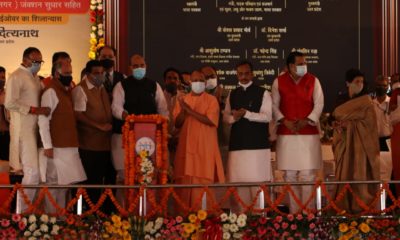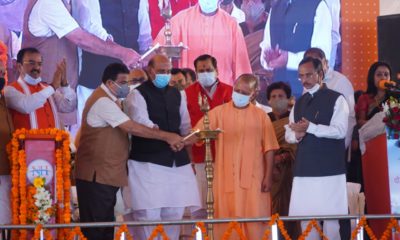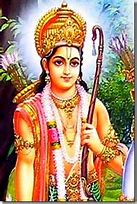Feature
Travelling to become smart in Lucknow city with smart cards

Lucknow: There is good news for the travellers of city of Nawabs as they will only need to swipe a smart card now to get railway ticket because northern railway has decided to fit cashless Cash Operated Automatic Ticket Vending Machines (COATVMs) by end of March at Charbagh railway station.
Speaking to media persons, some daily visitors to the city said it would be great for them as they use to travel with minimum cash.
An official from of a Charbagh station said, around six COATVMs will be installed in the second hall of the ticket booking at the railway premises and to use the machine, traveller will need to obtain the smart card from counter number five and can recharge it from Rs 10-5,000 as per usage.
The machine will give only unreserved tickets and passengers can also get platforms tickets by swiping the card, all though there is no limit of travel.
A traveller who works with a multi-national company, Mahesh Singh use to travel between Kanpur and Lucknow daily said, “I lose one hour daily in queue for ticket and this is good news for me as I can save time and go cashless.”
Another traveller, who is a Marketing manager in a private firm Smriti, has to travel every alternate day to new destinations said, “There are ATVMs at Charbagh which demand cash for every ticket and passenger often face technical errors but swipe card a better option.”
A senior citizen who is believed to be of 78-year-old Gurpreet Kaur was standing in a queue for a platform ticket said, every year railway comes up with good schemes for senior citizens but their employees never pay attention so the benefit of such schemes becomes worthless.
Divisional commercial manager M L Meena said that the smart card will be valid for six months and if passenger does not use it within given time, the balance amount will lapse.
She further added that railways have also appointed two supervisors to take care of the machine in case of technical error for day and night shifts.
Entertainment
Meghalaya Reserves Legalized Gambling and Sports Betting for Tourists

The State Scores Extra High on Gaming-Friendly Industry Index
Meghalaya scored 92.85 out of 100 possible points in a Gaming Industry Index and proved to be India’s most gaming-friendly state following its recent profound legislation changes over the field allowing land-based and online gaming, including games of chance, under a licensing regime.
The index by the UK India Business Council (UKIBC) uses a scale of 0 to 100 to measure the level of legalisation on gambling and betting achieved by a state based on the scores over a set of seven different games – lottery, horse racing, betting on sports, poker, rummy, casino and fantasy sports
Starting from February last year, Meghalaya became the third state in India’s northeast to legalise gambling and betting after Sikkim and Nagaland. After consultations with the UKIBC, the state proceeded with the adoption of the Meghalaya Regulation of Gaming Act, 2021 and the nullification of the Meghalaya Prevention of Gambling Act, 1970. Subsequently in December, the Meghalaya Regulation of Gaming Rules, 2021 were notified and came into force.
All for the Tourists
The move to legalise and license various forms of offline and online betting and gambling in Meghalaya is aimed at boosting tourism and creating jobs, and altogether raising taxation revenues for the northeastern state. At the same time, the opportunities to bet and gamble legally will be reserved only for tourists and visitors.
“We came out with a Gaming Act and subsequently framed the Regulation of Gaming Rules, 2021. The government will accordingly issue licenses to operate games of skill and chance, both online and offline,” said James P. K. Sangma, Meghalaya State Law and Taxation Minister speaking in the capital city of Shillong. “But the legalized gambling and gaming will only be for tourists and not residents of Meghalaya,” he continued.
To be allowed to play, tourists and people visiting the state for work or business purposes will have to prove their non-resident status by presenting appropriate documents, in a process similar to a bank KYC (Know Your Customer) procedure.
Meghalaya Reaches Out to a Vast Market
With 140 millions of people in India estimated to bet regularly on sports, and a total of 370 million desi bettors around prominent sporting events, as per data from one of the latest reports by Esse N Videri, Meghalaya is set to reach out and take a piece of a vast market.
Estimates on the financial value of India’s sports betting market, combined across all types of offline channels and online sports and cricket predictions and betting platforms, speak about amounts between $130 and $150 billion (roughly between ₹9.7 and ₹11.5 lakh crore).
Andhra Pradesh, Telangana and Delhi are shown to deliver the highest number of bettors and Meghalaya can count on substantial tourists flow from their betting circles. The sports betting communities of Karnataka, Maharashtra, Uttar Pradesh and Haryana are also not to be underestimated.
Among the sports, cricket is most popular, registering 68 percent of the total bet count analyzed by Esse N Videri. Football takes second position with 11 percent of the bets, followed by betting on FIFA at 7 percent and on eCricket at 5 percent. The last position in the Top 5 of popular sports for betting in India is taken by tennis with 3 percent of the bet count.
Local Citizens will Still have Their Teer Betting
Meghalaya residents will still be permitted to participate in teer betting over arrow-shooting results. Teer is a traditional method of gambling, somewhat similar to a lottery draw, and held under the rules of the Meghalaya Regulation of the Game of Arrow Shooting and the Sale of Teer Tickets Act, 2018.
Teer includes bettors wagering on the number of arrows that reach the target which is placed about 50 meters away from a team of 20 archers positioned in a semicircle.
The archers shoot volleys of arrows at the target for ten minutes, and players place their bets choosing a number between 0 and 99 trying to guess the last two digits of the number of arrows that successfully pierce the target.
If, for example, the number of hits is 256, anyone who has bet on 56 wins an amount eight times bigger than their wager.

























